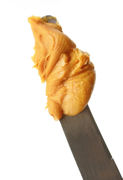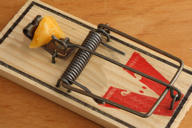Best Bait to Use for Catching Mice in a Nutshell:
One of the most successful baits for catching mice is peanut butter. Place it on a candy wrapper to enhance the aroma. The next most successful bait is nest making material like cotton wool. Remember, mice breed frequently so are always looking for materials to build new nests.
Full list of first class food baits:
Peanut butter, cream cheeses, smelly cheeses, chocolate fudge, marshmallow, jam, gumdrops, Vanilla extract, beef jerky, cooked streaky bacon, seeds, sausage, pet food (wet not dry food).
Popular list of nesting material baits:
Cotton wool, floss, shredded paper, wood shavings, string, yarn (glue or tie the bait to the trap so the mouse can’t just run away with it).
Now you know what bait to use, what’s next?
Keep reading to learn about the do’s and don’ts of baiting traps or click the link to discover which are the Top 3 Mouse Traps.
Table of Contents
1. Never Handle Mouse Bait with Your Bare Hands
3. Do Different Types of Traps Need Different Baits?
4. How Much Bait Should You Use?
5. Where Do You Place The Bait?
6. Where do You Place the Trap?
7. How Long Do You Leave The Bait In Place For?
8. How Often Should You Replace The Bait?
9. Don’t Get in a Hurry to Catch Your Mice
10. When You Start Trapping Mice, Go Big
1. Never Handle Mouse Bait with Your Bare Hands

Mice sniff their food before they eat it. That’s not because they are peanut butter connoisseurs. It’s because they won’t eat food that might be attracting a larger predator, such as you.
Mice can smell (what are for them) alarm pheromones from the sweat on your hands if you touch the bait with your ungloved hands. Wear gloves when you are handling mousetraps. Wear gloves when you are handling bait. And to prevent contact with E. coli, Salmonella, and Streptococcus bacteria, wear gloves when you are disposing of the mice you catch. Gloves used in health care, or for washing dishes, or for food preparation are adequate.
2. Choosing Your Mouse Bait
Successful fishing is mostly about using the right bait, and like fishing, if you don’t use the best bait for catching mice, you may not catch any mice at all. It’s true that mice will be attracted to just about any kind of food, but when you use the best bait, you will catch a lot more mice.
In the wild, mice mostly eat seeds and insects. However, while mice will be attracted to food, whatever it may be, they are known to practically lose their minds with desire when presented with peanut butter. In the winter, when mice are building nests, they go on the prowl for soft threads, but thread isn’t really a very practical bait. You would have to tie the thread to the trap so the mouse couldn’t just run away with it.
3. Do Different Types of Traps Need Different Baits?

Different types of mouse traps do not really need different baits. What will work for one trap will, by and large, work for all types of traps. However, there is one thing that all bait should have in common; they should be sticky, and not solid.
In Tom and Jerry cartoons the mouse bait is always a traditional chunk of cheddar cheese. The main problem with this is that it could be possible for the mouse to steal the cheese without triggering the trap. That’s why sticky bait works best. Examples of sticky bait include peanut butter, jelly, marshmallows or cream cheese.
Because the sticky bait cannot be lifted up and carried away by the mouse, it will have to eat it where it finds it and that will usually mean it will trigger the traps, sooner or later.
The exception to this rule is if you use poisoned bait chunks in a mouse bait station. This is solid, but it has a hole through the middle which is used to hold the bait in place in a bait station. This means the mouse can’t walk off with it.
4. How Much Bait Should You Use?
It isn’t necessary to use a lot of bait, and it is probably a good idea to use just a small amount. Use a teaspoon (5 g) or so. The idea is not to feed the mouse, but to entice it into the trap. For this reason you will need enough bait to produce a strong smell that the mouse can easily detect, without having too much bait.
5. Where Do You Place The Bait?
In the case of traditional mouse snap traps, the bait needs to be placed on the trigger mechanism. There are usually a few short metal spikes on the trigger to hold solid bait, but using sticky bait will work well too. Make sure the bait is held securely with snap traps, so that the mouse cannot steal it without triggering the trap.
With electronic mouse traps and humane traps, always place the bait as far into the trap as possible, right up to the far end. These type of traps depend on the mouse entering the trap far enough to complete an electric circuit, in the case of electronic traps, and triggering a mechanism that will close the door and prevent escape, in the case of humane mouse traps.
If the mouse can get at the bait without entering far enough to trigger the trap, then it will simply eat the bait and go away, thereby negating the reason for baiting the trap in the first place.
6. Where do You Place the Trap?
Mice keep close to cover. They navigate by keeping their whiskers in contact with a flat surface, such as a wall. They don’t ordinarily visit open spaces unless they absolutely must. You will need to leave baited traps close to a wall. It helps to place the narrower end of the trap against the wall so that whole trap is perpendicular to the wall. This forces the mouse to explore the trap while moving down its runway.
Whenever you can, place traps where mice have overhead cover. Under the stove is a great place for glue traps. Take out the oven drawer for easier access.
7. How Long Do You Leave The Bait In Place For?
If you have a serious infestation of mice, you will not be able to keep up with demand for the bait, so this will not be a problem. However, if you only have the occasional mouse problem, the bait may be left in the trap for several days without any mouse trying to eat it.
This could also mean you have positioned the trap in the wrong place. It needs to be placed where you detect the most mouse activity. However, if the mice are not taking the bait, and the trap is positioned right, you will need to change the bait regularly.
Mice are attracted to strong smelling fresh food, so keep the bait fresh. In hot weather that might mean changing it more regularly than in colder weather. In any case, don’t leave bait that is not seeing any mouse activity for so long that it becomes stale. Check your traps on a regular daily basis.
8. How Often Should You Replace The Bait?
It is best to replace the bait after each time a mouse is caught. It is likely that the mouse will have nibbled some of the bait before triggering the trap mechanism. Other mice might detect this, and while this may not deter them, it is best if they are presented with fresh bait every time.
You should also replace the bait if it is left in the trap without mouse activity for more than a few days to prevent it going stale.
9. Don’t Get in a Hurry to Catch Your Mice
A tiny, basically defenseless mouse will be very cautious about anything new in its environment. It’s best to put out bait without traps for a few days to help the mouse become accustomed to the intrusion. Putting out bait will also ensure that you are putting traps in the right place later. When bait starts disappearing on a regular basis, then put out your mouse traps (notice that’s mouse traps, plural).
10. When You Start Trapping Mice, Go Big
Don’t put out just one trap. Put out a dozen or two dozen traps. A single female mouse can give birth to six or seven babies in just three weeks. If you don’t have lots of mice now, you will soon. Because they multiply so rapidly, you need to catch them all.
Place at least one trap every 18 inches (50 cm) or so along highly trafficked areas, and for best results, place traps 2 or 3 inches (5 to 7 cm) apart along the entire length of any “rodent runway” you have identified by mouse droppings, mouse urine (visible by black light), or that icky mouse sludge that tends to accumulate when lots of mice travel down the same path at night.
11. Get As Many Mice as Possible the First Night

Mice are fast learners. Any mice that escape your traps the first night will be able to avoid them the second night. Take the time to identify rodent traffic patterns and to get the mice accustomed to their bedtime snack, and then put out as many traps as possible with as many different types of bait as possible.
For ongoing mouse catching, it’s OK to give the little pests a steady diet of peanut butter. But while you are getting the mice used to the presence of the bait and on the first night you set out traps, offer an all you can eat buffet. This is the one time it might be OK to leave out bacon, cheese, cold cuts, or hot dogs in very small amounts.
12. What Do You Do If The Mouse Doesn’t Take The Bait?
This is where testing comes in. Assuming you have a lot of mouse activity in the area, if the mice don’t take the bait in the trap, it could mean several things. It could be, for example, that they have a source of food that is easier to get at than the bait in the trap. One way to find out is to use a camera trap and catch them on video. Take a look at my top 3 camera traps here.
In addition ensure that the only food supply available is the bait in the trap. However, if the uptake of bait is still much lower than you would expect, then experiment with changing the bait on a fairly regular basis.
Leave new bait in the trap for a day or two, and if it is not being as effective as you would like, change it to something else and try again. Get inventive, think like a mouse, and you will be successful.

I think I only have 1 mouse. He ran along the side of my kitchen 4 nights ago and I am struggling to catch him. I put a humane tipping trap out the first night and he went in but managed to untip it back and open the trap door and escape. The second night it the trap had closed but no mouse. I suspect the mouse ran by and his motion tipped it. Do I need to change my trap because the mouse has discovered what happpens? Also I have hunted far and low and cannot see any mouse droppings.
Hi – yes the mouse is probably on to you. If they are, use more traps and use different types of bait. However if you only saw one mouse and there is no evidence of it still being in your home then it may well have gone. Keep vigilant and if you see it or evidence of it again put the traps back down.
My surefire baiting method is to tie two Cheerios, or a goldfish cracker to the trigger mechanism using some fishing line (6 lb. test). Most traps have a hole or loop to string the line through. I have NEVER had the mouse steal the bait without getting caught.
Good hunting.
Thanks for the tip Phil.
Simon
Best way to kill them! Glue a peanut or whatever you have to the victor mouse trap trigger. The mouse will get frustrated and eventually try and grab it. I was using peanut butter but had no success kept walking back to traps licked clean. This trick has produced everytime, even glued dog or cat food works!
That is a novel idea, I hadn’t heard of that before. I’ve heard of tying bait to a trap, but I definitely like the idea of gluing it. Interesting to note that the smell of the glue does not put them of.
Simon
I have a mouse that doesn’t pay rent in the house. I set up two snap traps. This mouse is so smart he ate the bait but trigger didnt snap. I tried a second time. He still ate the bait but pushed the trap to my walk area. I was looking for the traps and they snapped on two toes. The mouse is a college graduate from Micky mouse university it seems. My shotgun worked but have to fix bullet holes in house.
Ha ha good story Micky!
Simon
My problem with sticky bait is that the mice will lick off the peanut butter without triggering the trap. The solution I’ve found is to use the Kraft style American cheese singles as bait. It’s still squishy enough that it will squeeze into the trigger and stick, but not fluid enough that they can lick it off the trigger. I’m still working on figuring out how they’re getting in…
Hi Rob,
That’s a great tip thanks.
Simon
I have 2 mice in my room. I csught one this morning using sticky traps but the other one is very clever and avoided the sticky pads.any ideas on how to get ridl
Place the sticky traps either side of a snap trap.
Hello I believe I have 1 mouse I can’t catch this thing to save my life I have laid out so many glue traps he will not take it I have tired peanut butter cheese.beef jerky, marshmallows chocolate, two different cakes hot dogs raw chicken chicken nuggets french fries I can’t catch him it seems that it’s may be avoiding the glue trap because I still see the droppings but doesn’t take anything from the glue trap
Hi Malikka,
Mice will tend to follow the same path, are the droppings normally in the same place, can you determine the mouse’s route from the droppings?
Try using a combination of traps, e.g. glue traps either side of a snap trap. Place the traps along the path the mouse takes. Do not handle the traps with your bare hands as mice can smell your scent.
You could also try setting out bait without traps to see if is being eaten.
Let us know how you get on.
Simon
Because of our very small house most of the skirting board is covered by furniture etc. As a result it is virtually impossible to put the traps against the wall. Our mice are quite happy to come into the centre of the room and hastily scurry back under the furniture when ever they detect movement. So…….where do we set our electronic mouse traps if not against the wall?
You have two options. Mice normally follow the same path whenever moving around a house, you can normally detect this path by their mouse droppings. You then place the trap on this path.
If you don’t want a big mouse trap in the middle of your room, you can try putting snap traps under furniture, in addition, place a glue trap either side of the snap trap.
we have mice that have taken the poison from traps, corn for our stove and stored them in different places. We will catch some in traps with peanut butter. But wondered what type of mice store the food. The ones that took the D-Con cleaned out the boxes every night, never found a dead mouse but they emptied 4 boxes and stored it in the accordian case.
I haven’t of that before lol. Mice are very smart, and we are heading for mid-winter. They could be thinking about creating a nest in your accordion case.
However, if they are successfully removing food from traps and not getting caught. Place glue traps either side of your existing traps.
Simon
I had a question as far as bait stealing goes. I placed 4 snap traps with peanut butter as the bait. I made sure to squeeze it into the little tube on the trigger and everything. I check on the traps daily, and 99% of the time the trap is licked clean but not tripped. Is this a problem with the trap, or just a coincidence? Lol i did find one tripped the other day but nothing in it and licked clean too…. help?
You obviously have some light-fingered mice. Have you tried putting a glue trap either side of the snap trap?